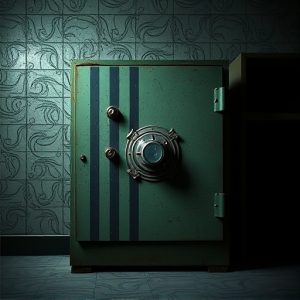Hidden Safes in Plain Sight: Mastering the Art of Camouflage for Secure Storage
Hidden safes integrated into everyday settings offer a discreet and secure solution for storing valu…….
Hidden safes integrated into everyday settings offer a discreet and secure solution for storing valuable assets. These cleverly disguised vaults are expertly crafted to blend with their surroundings, whether it's a bustling city center or a tranquil park, and are strategically placed to be both accessible and inconspicuous. The collaboration between architects and security experts leads to these safes being both aesthetically pleasing and functionally secure, with advanced features like biometric locks and electronic surveillance systems. They serve various sectors, including public safety and emergency services, by ensuring that authorized individuals can access the contents when necessary. The art of hidden safes in plain sight lies in their ability to maintain visual normalcy without compromising on the protection of valuables and sensitive information. As concerns for privacy grow, these hidden safes stand as a testament to the fusion of security with design, making them an essential investment for those prioritizing safety within an aesthetically pleasing environment.
Hidden safe rooms, often camouflaged as unassuming elements within public spaces, offer a fascinating intersection of design and security. This article delves into the artful placement and intricate craftsmanship of these concealed vaults, known as hidden safes in plain sight. We explore how architects seamlessly integrate them into everyday landscapes, providing a blend of privacy and security that appeals to individuals and institutions alike. Join us as we uncover the layers behind the design and functionality of these discreet safe havens, ensuring safety without compromising aesthetics.
Unveiling the Art of Camouflage: The Design and Placement of Hidden Safes in Public Spaces
The art of concealment has long been a cornerstone in the protection and security of valuables, with hidden safes in plain sight representing a masterful blend of design and stealth. These covert vaults are meticulously integrated into everyday environments, often overlooked by the untrained eye. Architects and security experts collaborate to create these discreet containers, ensuring they complement their surroundings without drawing attention to their true purpose. The placement of hidden safes is strategic, situated in locations frequented by the public yet remote enough to avoid unwanted scrutiny. These sites vary widely, from the bustling corridors of urban hubs to the tranquil corners of serene parks, all serving as a testament to the ingenuity behind their integration.
Furthermore, the design of these hidden safes is not merely functional but also aesthetically pleasing, often indistinguishable from public installations or common fixtures. Materials and finishes used are chosen to age and wear in a manner consistent with their apparent function, maintaining the illusion of an ordinary object long after installation. The camouflage employed is sophisticated, utilizing elements that contribute to the ambiance of the locale while providing secure storage for sensitive items. This careful balance between form and function ensures that these hidden safes remain unobtrusive, yet accessible to authorized personnel when necessary, making them invaluable assets in various applications, from public safety to emergency response coordination.
Architectural Intrigue: How Hidden Safes Become a Part of Everyday Landscapes Without Missing a Beat
Integrating hidden safes into everyday landscapes has become an art form, blending seamlessly with architectural design to create what can be termed ‘hidden safes in plain sight’. These covert vaults are craftily embedded within structures, often indistinguishable from their surroundings. Architects and security experts collaborate to devise innovative concealment methods that transform what could be a security feature into an architectural element of intrigue. The result is a harmonious blend where safety enhances the aesthetic appeal rather than detracting from it. For instance, a bookshelf might offer a secret compartment accessible only by a code known to the owner and a select few. Similarly, a piece of artwork or an ornate piece of furniture could conceal a safe with a high-security rating. This integration not only protects valuables but also adds an element of mystery and sophistication to a space, ensuring that security measures do not disrupt the ambiance or functionality of the environment. The design and placement of these hidden safes are meticulously planned, often drawing inspiration from historical camouflage techniques to ensure they remain concealed even to the most discerning observer. As such, hidden safes in plain sight become a subtle testament to innovation within the realm of architectural security.
The Allure of Anonymity: Exploring the Security and Privacy Benefits of Integrated Hidden Safes
Hidden safes integrated into everyday objects offer a discrete solution for those seeking enhanced security and privacy. These cleverly designed concealments blend seamlessly with their surroundings, allowing valuable items or sensitive information to be stored securely while remaining unobtrusive. The allure of anonymity is a significant draw for individuals who value discretion in both residential and commercial settings. These safes, often referred to as ‘hidden safes in plain sight,’ are not just security devices but are also lifestyle enhancers that provide peace of mind by protecting against theft, natural disasters, or unauthorized access. The integration of advanced security features such as biometric locks, combination codes, and even electronic surveillance deters potential intruders and ensures that only authorized users can gain access. This level of control over one’s possessions and private data is a modern necessity for individuals who are increasingly aware of the importance of personal privacy in an interconnected world. The aesthetic appeal of these safes complements their functionality, as they often double as furniture or functional fixtures, ensuring that security does not compromise design or lifestyle comfort.
A Closer Look: The Craftsmanship and Techniques Behind the Creation of Discreet Safe Spaces
Crafting hidden safe rooms that blend seamlessly with their surroundings is an art form, one that requires a deep understanding of both design and discretion. The creation of these spaces begins with meticulous planning, ensuring that the safe remains in plain sight, undetected by the uninitiated. Skilled artisans employ a variety of techniques, from integrating safes into everyday furniture to concealing them within architectural elements like false walls or bookshelves. The goal is to create an appearance of ordinary objects or areas, while actually offering secure storage for valuables or sensitive information. These hidden safes are often disguised as innocuous items: a painting on the wall, a floorboard, or even a light switch could conceal a door to a secure room. The materials and methods used are diverse, ranging from unobtrusive hinges to advanced locking mechanisms, all carefully selected to maintain the safe’s camouflage. The outcome is a masterful blend of functionality and invisibility, where safety is not just an added feature but an integral aspect of the space’s design. This craftsmanship ensures that these hidden safes in plain sight remain undetected until the moment they are needed most.


